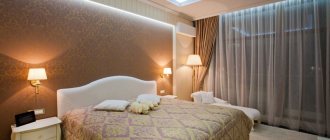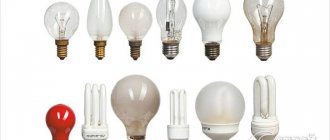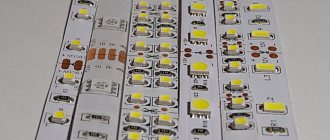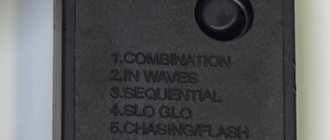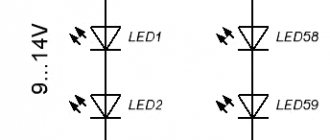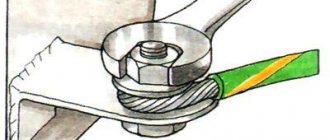LED lighting: what attracts and repels people
Disagreements periodically arise among manufacturers of various LED lamps and their buyers. The former, when advertising their products, promise high performance. And the latter are often disappointed.
Manufacturers claim:
- low power consumption;
- long service life;
- durable design, resistant to mechanical stress;
- uniform lighting without flicker;
- stability of light during voltage fluctuations in household wiring;
- no heat generation;
- silent operation;
- ease of installation;
- original creation of lighting effects.
However, there is no secret that:
- at a great distance from the source, the uniformity of illumination is disrupted and spotting increases;
- with increased heating, the semiconductor junction of the LED increases resistance and deteriorates illumination;
- The lamp consists of one or more series-connected chains of LEDs. As soon as one of them burns out, the entire circuit stops working;
- A whole network of low-quality manufacturers has formed on the market, who, for the sake of profit, simplify the design of lamps and create not gentle, but rather harsh operating conditions for them. This leads to a sharp reduction in the service life of devices purchased at a high price;
- It is the high cost of such lamps that often makes a potential buyer refuse to purchase it.
How to choose the right LED lamp according to technical standards
The sale provides a wide range of LED lamps for household purposes. You should navigate it well.
To do this, manufacturers indicate the main technical characteristics on the packaging. I'll tell you more about them.
But you will have to remember the theory a little.
How does an LED lamp work?
The lamp is based on an LED that emits light by passing electric current through a semiconductor junction.
It glows only when passing through direct polarity, and is extinguished when it is reversed.
Therefore, it is always included in direct current circuits, and not alternating current, where blinking will be observed due to pauses created by negative semiharmonics.
Below I show a simple picture of how an LED lamp works.
On it you see:
- socket for connection to the cartridge;
- power driver;
- a chain of series-connected semiconductor junctions (LED modules).
That's the whole device. There is nothing superfluous.
What types of base are there?
Any LED lamp is connected to the wires by screwing it into an electric socket, and it can be different for lamps. The main types of base are marked by thread diameter and designated: E12, E14, E27.
For comparison: the E27 base type is widely used in incandescent lamps.
LED Lighting Specifications
Luminous output
This is a general parameter for all types of lamps. It shows how efficiently the source converts applied electrical power into luminous flux.
The basis is 1 watt of electricity. LEDs, as you can see, convert it most efficiently.
Additionally, compare their lighting in terms of ultraviolet and infrared spectra, heat generation with other popular lamps.
Illumination and brightness of LED lamp
Luminous intensity is measured in a unit that is easy to remember: the candella (cd). Luminous flux is usually taken into account in solid angle: 1 steradian.
The unit for measuring luminous flux is 1 lux, and illumination is 1 lumen. I drew their relationships with formulas in explanatory pictures.
Colorful temperature
The human eye does not perceive the color spectrum equally, but it is determined by the wavelength of the electromagnetic vibration.
Doctors evaluate it by its tonic (irritant) and calming effect.
Therefore, the color temperature of the lamps is indicated on the packaging: it is important for health and is selected for specific people.
Light scattering angle
Each LED shines with a narrow beam, and not in all directions. When they are assembled into a common lamp, they try to eliminate this optical defect by design measures.
The most common LED lamps create lighting at 30, 60, 90 angular degrees.
Designers take this indicator into account when designing the interior or when creating various work areas in the premises.
Remember that with increasing distance from the lamp, uneven illumination may occur due to the formation of visible spotting of the surface.
LED lighting in the interior
Let's consider the use of LED lamps in the design of different rooms.
A small room can be visually expanded by running an LED strip along the perimeter of the ceiling and installing spotlights with diode bulbs. In this case, a traditional chandelier should not be installed, because it will steal the space.
A house or apartment of average size gives scope for design imagination. Often they make a multi-level ceiling of different shapes, along the contour of which tape is glued. LEDs can be installed in different colors, switching them depending on the time of day and the mood of the owner of the room. The mirror elements framed by diodes also look original. This technique allows you to play with space, making it deeper and more interesting.
Large rooms are zoned with light, partitions, textiles, and ceiling structures. A large room can be divided into several zones and each can be highlighted with light of different intensities. So, in the sofa area you can put filters on diode lamps and the light will be soft and diffused. In the reading area, direct light from diodes is relevant; in the TV area, a frame around the TV with an LED strip is appropriate; it does not cast glare on the screen and can make watching programs quite comfortable.
Why does an LED lamp burn out before the specified time and how to protect it
The design of the lamp is based on a set of LEDs. When they fail, many people think they were poorly made. However, this opinion is wrong: you need to pay attention to the conditions of their operation.
The semiconductor junction of an LED can operate stably only if the technical standards developed for its operation are strictly observed. These include:
- quality of the supplied voltage, ensuring the flow of standard current through the LED;
- temperature regime.
What role does the driver play?
It is entrusted with a very important task: maintaining a stable voltage on the LED to generate optimal current.
The fact is that the light characteristics directly depend on the magnitude of the current passing through the semiconductor junction, and it fluctuates greatly even with a small voltage deviation.
Current surges sharply deviate the luminous flux characteristics from the ideal form and at the same time increase energy losses due to thermal conversions.
A high-quality driver, creating optimal power, maintains not only a normal level of illumination, but also ensures a long service life of the lamp.
Cheap lamps use a simple driver that lowers the voltage at the input of the diode bridge with a resistive-capacitive resistor and smoothes out the rectified ripples with an electrolytic capacitor of increased capacity.
Such drivers cannot ensure stable flow of a normalized amount of current through the semiconductor junction. Therefore, the lamps powered from it will burn out during voltage surges.
The LED lamp driver is already of medium complexity and has galvanic isolation and a built-in microcircuit.
Turning on a transformer in the power circuit ensures that the currents flowing to the LEDs are detuned from the effects of faults in the primary power circuit 220.
How to protect an LED lamp from burning out
There are several ways to save the performance of LEDs from frequent malfunctions that occur in the power supply network:
- installing an expensive voltage stabilizer of any design (relay, electronic, with a servo drive) in the apartment;
- installing a varistor in the power supply circuit of a lamp or SPD on the input panel;
- series connection of a quenching resistor or capacitor.
The latter method limits the current through the LED, forcing it to constantly operate in a gentle mode with reduced light output.
The varistor cuts off the pulse peak and burns out, cutting off the emergency current path. In a simplified way, his work can be represented by the following picture.
Manufacturers produce ready-made modules for lamps that have built-in overvoltage protection.
This circuit is not difficult to assemble with your own hands.
How does an LED work when heated?
Numerous studies by scientists have revealed the influence of temperature on the life of each LED design.
When heated, they fail faster, but in cold weather they work great. All high-quality lamps have good heat dissipation by powerful radiators.
However, not all masters fully understand this issue and make numerous mistakes.
When installing LED lamps in suspended and suspended ceilings, you must take care of at least the normal operation of natural air exchange or ventilation . If you neglect heat removal, you will have to frequently replace them with new ones: they will burn out.
Characteristics
The main characteristics of emitting diodes include:
- operating current – the current value at which the lamp operates stably;
- voltage - the power that is needed for the device to operate;
- power is an important indicator that is needed when choosing a power supply;
- color temperature - the shade of the glow, it can be warm, neutral and cold;
- luminous flux - amount of light per 1 sq.m.;
- scattering angle – determines the area to which the lighting will be directed.
The characteristics also include crystal size.
Calculation of required brightness
Before buying lamps, determine what brightness you will need. This parameter should take into account the area of the room, its purpose, what function the lamps will perform. According to the standards for 1 sq.m. the living room should have 300-400 Lux of light, for the kitchen and bedroom about 250 Lux, for the hallway 100 Lux.
Light control
You can control the brightness of the lighting in various ways. These include:
- changing the number of diodes;
- change in current flowing through diodes;
- using the power regulator.
You can purchase a lamp with a dimmer. With its help you can adjust the brightness of the backlight.
How to install LED lamps in building structures
Installation and fastening of LED lighting fixtures is carried out in the same ways as for other lamps. Only modern tools and fasteners have made this technology a little easier.
There are two types of lamps used in household lighting:
- external: sconces, chandeliers and the like;
- point, built into a suspended ceiling or furniture elements.
How to install a chandelier on the ceiling simply and reliably
In Soviet times, in all multi-story buildings, builders immediately brought wires to the location of the future lamp and concreted steel wire for its suspension.
There were few effective tools for processing concrete back then. They mainly used a bolt and a hammer. Punching a hole in a slab with them is not easy. The mounting for the chandelier was made in advance.
Now every craftsman has a hammer drill. They make holes for installing fasteners in a fraction of a minute. They are made in two types:
- end-to-end;
- part of the slab thickness.
The first type of holes is used for installing plastic dowels. A prepared threaded hook is screwed into them or a fastening strip is mounted.
This method is suitable for relatively light chandeliers and lamps.
Through holes allow you to secure massive objects. To do this, install a lock washer on the back side of the plate and screw in the nut.
When access to the work site is limited, they use the installation of a fastening element on a rotating mechanism with an axis of rotation and one or two locking stops.
If a suspended or suspended ceiling is used, the chandelier is installed on it using a mounting adapter that serves as an intermediate element.
This height adapter fills the entire space between the decorative surface of the ceiling and the lower plane of the concrete slab. It is attached in any available way to the base building structure, and the chandelier is directly installed on it.
If you have a wooden house, then the work is simplified: there are a large number of ready-made hooks with regular threads for self-tapping screws on sale. It allows you to screw the fastener directly into the beam. The chandelier is hung on this hook.
How to install a spotlight in a suspended or suspended ceiling
The sale provides various adapters that allow you to install LED lamps at a certain distance from the base surface of the building structure: it is chosen as the basis for the stretch ceiling indentation.
The main bracket is attached to the concrete slab with self-tapping screws and dowels, and the adjusting bracket is fixed in it with locknuts or screws along with the spotlight socket.
This control unit allows you to very accurately combine the working planes of the lamp and the stretch ceiling fabric.
However, many craftsmen prefer not to buy ready-made adapters, but make them themselves from fasteners for assembling suspended structures.
Two metal plates that determine the height of the indentation of a stretch or suspended ceiling are taken with a margin of length. When the spotlight is assembled, these plates are simply bent or stretched to the required size.
For suspended ceilings made of plasterboard and other similar durable materials, special fixtures for lamps with spring latches are available.
They spread their arms to the sides, then insert the lamp into the prepared hole and release it. The latches move apart under the action of springs and fix the body of the spotlight in the ceiling.
Selection criteria for apartment lighting
Modern designers have a lot of options for using LEDs in interior design and more.
Let's look at everything in more detail:
- Small spaces, rooms. As a rule, small lamps and LED strips are very appropriate here. This allows you to expand the space and beautifully emphasize the contours of the room. Large lamps would be inappropriate here.
- Apartments and houses are medium in size. Here we have much more liberties. It is very popular these days to install various plasterboard ceilings of the most interesting shapes, after which LED strips are used to create a frame that creates a feeling of greater height. Another very popular idea is a mirror ceiling with LEDs located along the contour, and the more bizarre its shape, the more interesting it looks.
- Large apartments and premises. The large space allows us to try to combine a variety of lamps, in color and brightness of light. We can combine various LED strips in multi-level ceilings, and a wide variety of zoning is also possible. You can very elegantly make air partitions and beautifully decorate niches using LED strips of different brightness. The design of various ceiling vaults using white and blue light looks very elegant.
LED chandelier with remote control in room design
If in appearance it still resembles an ordinary lamp with traditional incandescent lamps, then its internal design is distinguished by a complex electronic filling, consisting of:
- built-in radio receiver and controller;
- remote transmitter installed in the control panel.
The remote control allows you to remotely turn on or off the light, and adjust the degree of room illumination at a distance from the switch.
Manufacturers specially encrypt radio remote control signals from the remote control transmitter to the chandelier receiver with different codes. This makes it possible to exclude accidental switching on of lighting devices by extraneous commands coming from neighbors in multi-story buildings.
However, there are also inconveniences to this. I came across them when repairs were needed.
The fact is that an LED chandelier with a butterfly-shaped remote control, shown in the topmost picture, was purchased for the grandchildren’s children’s room. The eldest boy did not go to school yet, but he really liked to show his little sister various lighting effects.
She really liked this lighting. Both received a lot of positive emotions. But, after about six months of intensive switching on, the chandelier stopped working from the remote control.
I had to start repairing it, which boiled down to buying and replacing the controller and remote control, which I previously described in a separate article.
Replacing the controller took no more than half an hour. The grandchildren were very pleased that it was working again.
An LED chandelier does not heat surrounding objects like incandescent lamps. It is well suited for installation in suspended ceilings.
However, when choosing its design, I recommend paying attention to the design of the room. She must:
- match the color of the interior;
- correspond in size to a safe location at ceiling height;
- meet the purpose of the room (not for the corridor and hallway);
- match the design solutions with its shape and design.
For example, expensive chandeliers with crystal inserts are chosen for lovers of the classics; rectangular or round “tablets” are created for the Art Nouveau style with low ceilings.
The range of color shades that LEDs create is quite extensive. They should be taken into account when creating the interior:
- yellow tones calm and help you relax;
- white improves performance;
- reds stimulate the body, providing a tonic effect;
- green enhances the attention necessary for creative activity;
- blue helps you relax and relieve tension.
